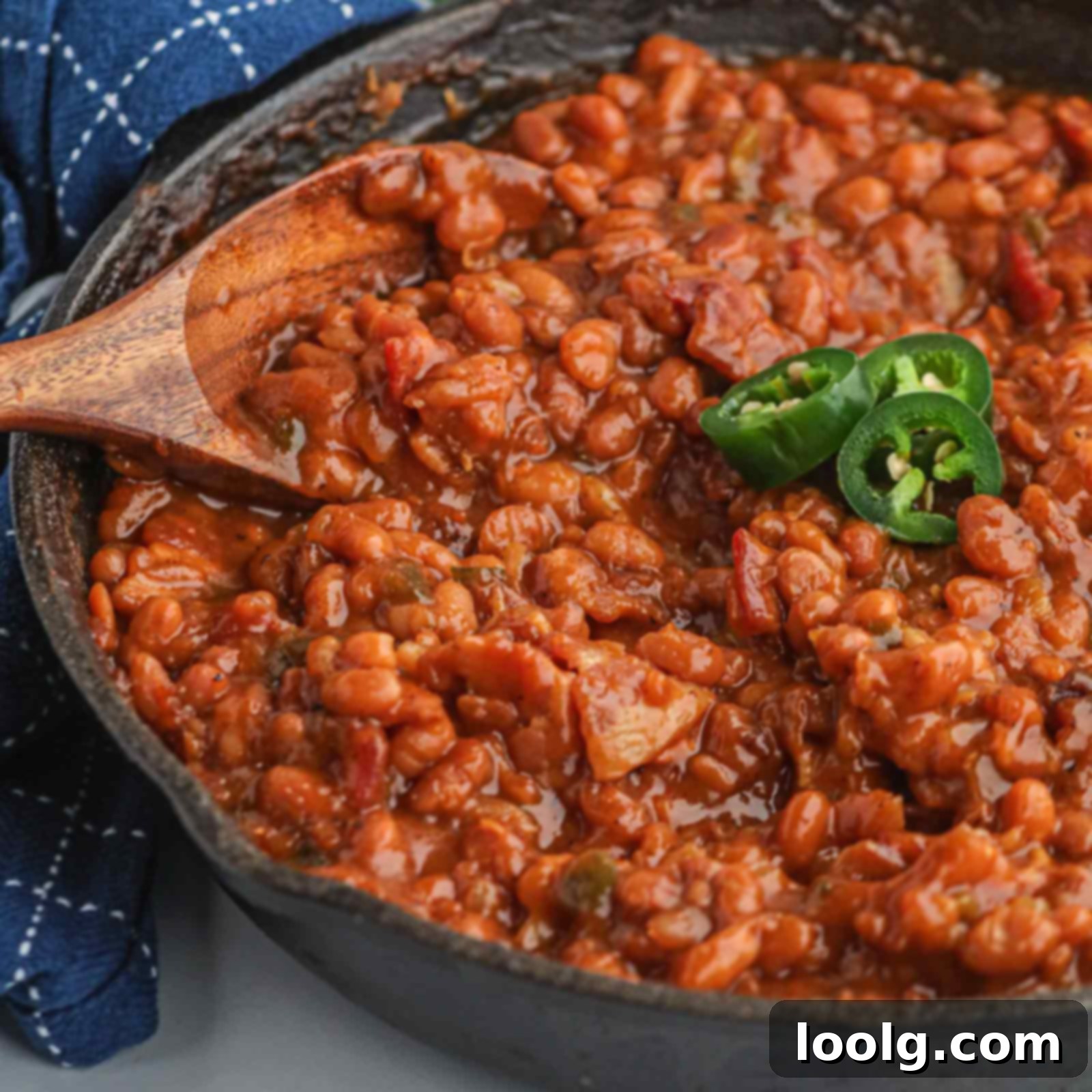Ultimate Smoked Baked Beans: Sweet, Smoky & Savory Perfection for Your BBQ
Get ready to elevate your barbecue game with these incredibly delicious **smoked baked beans**. This recipe delivers a harmonious blend of smoky, sweet, and tangy flavors, all prepared in a single cast iron skillet. We’re talking about a side dish so rich and satisfying, it might just steal the show from the main course! Featuring thick-cut bacon, a touch of dark molasses, and a bright splash of apple cider vinegar, every spoonful is an adventure. The secret lies in a low-and-slow smoke, gently weaving all these magnificent ingredients into a rich, deeply flavored, and perfectly saucy finish that’s truly irresistible.
These beans aren’t just a side; they’re a crowd-pleasing culinary experience, designed to complement any hearty main course, from smoked ribs to grilled chicken. Imagine them alongside this Smoked Mac and Cheese for the ultimate comfort food feast! Plus, they are naturally gluten-free and dairy-free, making them a fantastic option for guests with dietary considerations. However, it’s always a good practice to quickly check your pork and beans and ketchup labels to ensure all ingredients align with your dietary needs.
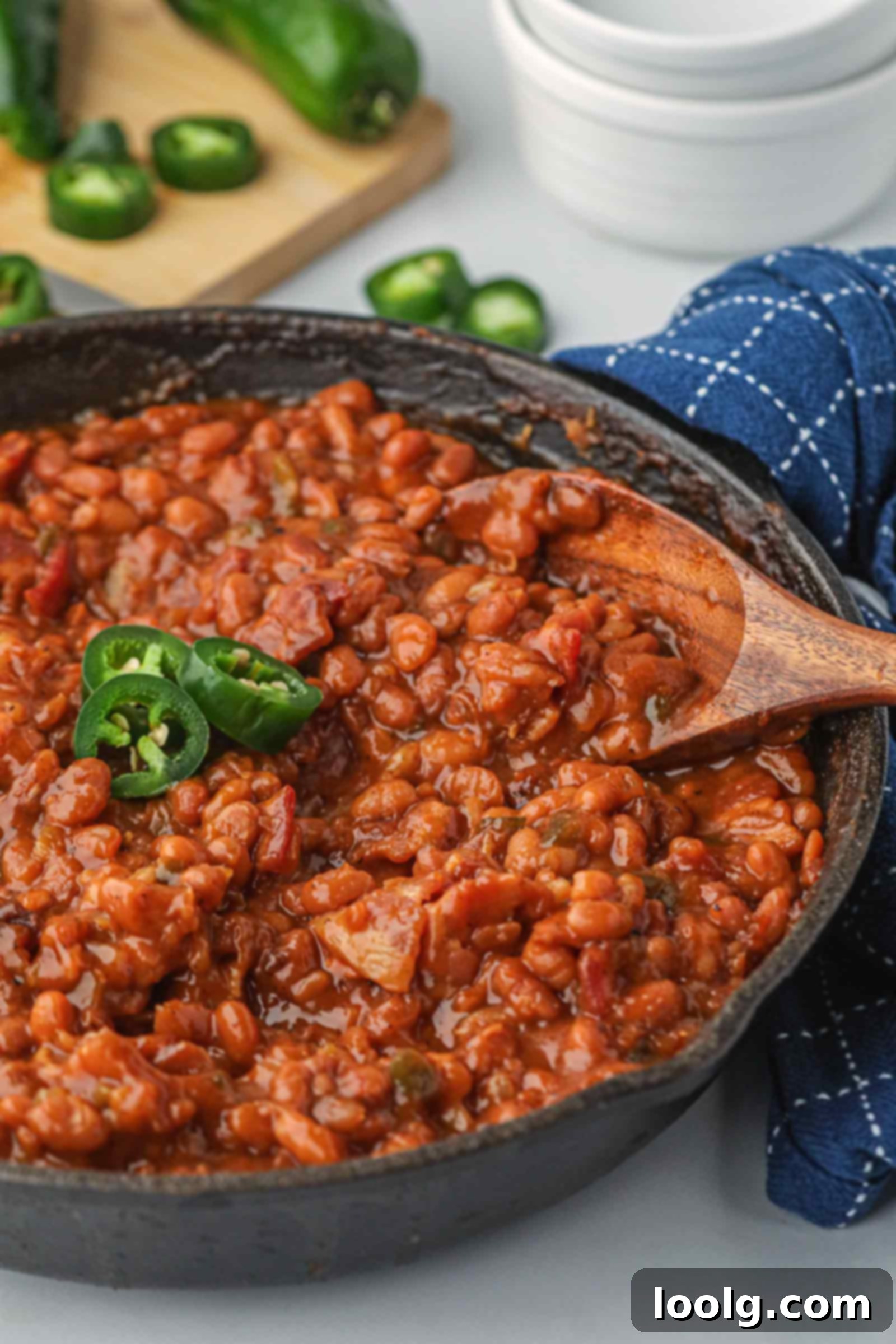
Why You’ll Love These Smoked Baked Beans
- Unforgettable Comfort-Food Flavor – Prepare for a symphony of tastes! These smoked baked beans are a perfect balance of smoky depth from the low-and-slow cooking, a delightful sweetness from brown sugar and molasses, a subtle tang from apple cider vinegar, and savory richness from the bacon. Every bite is a journey into classic American comfort food, elevated by the unique dimension of smoke. They’re designed to be complex yet incredibly approachable, making them a staple for any barbecue enthusiast.
- Effortless One-Pan Cooking – Simplicity is key, especially when you’re hosting a barbecue or simply enjoying a relaxing weekend. This recipe requires just one 12-inch (30 cm) cast iron skillet from start to finish. This means minimal cleanup and more time to savor your culinary creation and the company of friends and family. The robust cast iron also ensures even cooking and excellent heat retention, ideal for both stovetop preparation and the extended smoking process.
- Incredibly Easy to Customize – While the base recipe for these smoked baked beans is exceptional on its own, it also serves as a fantastic foundation for your creative culinary twists. Feeling adventurous? Increase the heat by leaving more seeds in the jalapeños or adding a pinch of cayenne pepper. For a heartier dish, stir in leftover smoked meats like pulled pork, chopped brisket, or your favorite smoked sausage. You can also experiment with different wood types in your smoker to fine-tune the smoky essence to your precise liking, from subtle fruitwood notes to bold hickory.
Key Ingredients for Perfect Smoked Baked Beans
Crafting the best smoked baked beans starts with understanding the role each ingredient plays. Below are some detailed notes on the essential components that bring this dish to life, contributing to its rich flavor profile and irresistible texture. Remember to scroll down for the complete, printable recipe card with exact measurements!
- Thick-Cut Bacon – This ingredient is paramount for truly standout baked beans. Unlike regular, thinner bacon, which can break down and almost vanish during the long cooking and smoking process, thick-cut bacon holds its own. It retains a satisfying, meaty texture in every bite, providing a delightful chew. Moreover, the larger pieces caramelize beautifully, contributing a profound smoky and savory depth that perfectly counterbalances the inherent sweetness of the beans. It’s truly the foundational flavor booster for this recipe.
- Yellow Onion & Jalapeño – These aromatic vegetables form the essential base layer of flavor. The yellow onion softens and caramelizes as it cooks, imparting a natural sweetness and body to the sauce. The finely diced jalapeño introduces a vibrant, fresh brightness to the mix. For those who prefer a milder flavor, simply remove the seeds and membranes from the jalapeños; this way, you get all the delicious pepper flavor without the intense heat. If you enjoy a kick, feel free to leave some or all of the seeds in. Any leftover jalapeños can be brilliantly utilized in recipes such as this Qdoba Tortilla Soup or a refreshing Southwest Chicken Salad.
- Canned Pork and Beans – This recipe embraces the convenience and consistent quality of canned pork and beans as its primary base. This choice ensures an easy preparation and a reliably delicious outcome every time. A critical note: do *not* drain the cans! The flavorful liquid is integral to the sauce, helping all the ingredients meld together perfectly during the low-and-slow smoking process, and contributing significantly to the final thick, rich consistency. Selecting a brand you genuinely enjoy is key, as it provides the core essence of the dish.
- Light Brown Sugar & Molasses – These are the stars for creating that classic sweet and savory depth. Light brown sugar melts into the sauce, offering a soft, caramel-like sweetness. Molasses, particularly a rich, unsulphured variety (avoiding blackstrap molasses, which can be too bitter), adds a distinctive, deep, slightly smoky, and complex sugary note that is absolutely essential for authentic, old-fashioned baked beans. Together, they create a beautifully balanced sweetness that is rich and satisfying without being cloying.
- Ketchup – Far more than just a table condiment, ketchup plays a crucial role in this recipe. It contributes a vital tangy sweetness and a robust tomato base that helps to thicken the sauce and infuses the beans with a familiar, comforting flavor profile. It’s a key component in achieving that beloved, classic baked bean taste that resonates with so many.
- Apple Cider Vinegar – This humble ingredient is a true game-changer, acting as the secret weapon to balance all the rich, sweet, and smoky elements. A generous splash of apple cider vinegar provides a much-needed bright acidity and tang. This tartness cuts through the richness, preventing the beans from becoming overly sweet and adding a refreshing layer of complexity that makes each bite more intriguing.
- Dry Mustard – Often overlooked, dry mustard (like ground mustard powder) is a powerful yet subtle flavor enhancer. It doesn’t contribute a strong “mustard” flavor but rather serves to sharpen the overall profile, helping to cut through the sweetness, adding a subtle savory depth, and rounding out all the flavors for a well-balanced and sophisticated taste. It’s a small addition that makes a big impact.
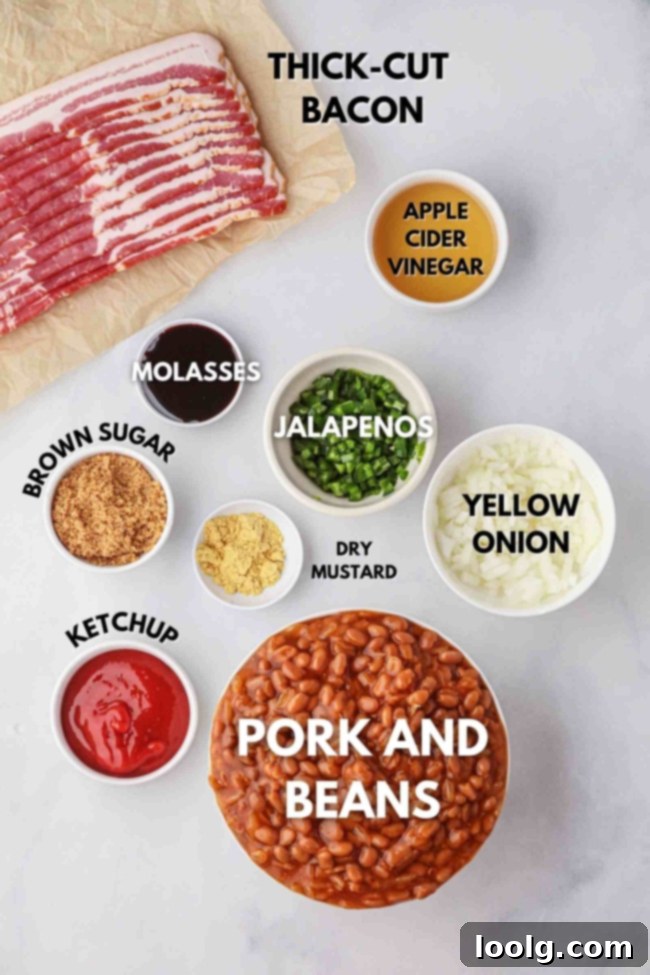
Essential Equipment for Smoked Baked Beans
Beyond the ingredients, having the right tools on hand will ensure your smoked baked beans come out perfectly every time. Here’s a look at the key equipment you’ll need to create this fantastic dish:
- Smoker + Wood – A reliable smoker is the heart of this recipe, infusing the beans with that signature smoky depth. You’ll want to set your smoker to a consistent low temperature, around 250°F (120°C), for the ideal slow-cooking and smoke infusion. When it comes to wood, I highly recommend mild fruitwoods such as **apple or cherry**, or the delightfully nutty notes of **pecan**. These options impart a gentle, complementary smoke that enhances without overpowering the beans’ natural flavors. If you’re seeking a more assertive, traditional barbecue smoke profile, **hickory or oak** are excellent choices, but be aware their flavor is more pronounced and should be used with a lighter hand if you prefer a less intense smokiness. Any type of smoker capable of maintaining a stable low temperature (pellet, offset, electric) will work beautifully.
- 12″ Cast Iron Skillet – This specific piece of cookware is absolutely crucial for a successful batch of smoked baked beans. You need a standard 12-inch (30 cm) cast iron skillet that is sufficiently deep to comfortably hold the entire volume of beans without the risk of bubbling over during the smoking process. Cast iron is the material of choice here because of its superior heat distribution, exceptional heat retention capabilities, and its ability to develop a beautiful, flavorful crust on the beans where they meet the pan. Its robust nature also allows it to transition seamlessly from stovetop preparation to the smoker. A shallow skillet, unfortunately, will not suffice as the beans expand and bubble when cooked low and slow.
How to Make the Best Smoked Baked Beans
Follow these detailed steps to create a truly unforgettable side dish that will be the talk of your next gathering. The magic happens with a little patience and the wonderful influence of low-and-slow smoke.
- Prepare the Smoker and Bacon: Begin by preheating your smoker to a stable 250°F (120°C). As it heats, load it with your preferred mild wood – apple, cherry, or pecan are excellent choices for a balanced smoke. While the smoker comes up to temperature, place your 12-inch cast iron skillet on your stovetop over medium heat. Add the thick-cut bacon and cook until it’s about halfway done and has partially rendered its fat on both sides. This usually takes around 4-7 minutes; the bacon should still be pliable, not yet fully crispy.
- Drain Fat and Chop Bacon: Carefully remove the partially cooked bacon from the skillet and transfer it to a plate lined with paper towels to drain any excess grease. It’s important to leave approximately 2 tablespoons of the rendered bacon fat in the skillet, as this flavorful oil will be the base for our aromatics. Once the bacon has cooled enough to handle comfortably, chop or crumble it into bite-sized pieces; this ensures a delightful, meaty presence in almost every spoonful of the finished beans.
- Sauté Aromatics: Return the cast iron skillet, now containing the reserved bacon fat, to medium heat on the stovetop. Add the diced yellow onion and the finely diced jalapeño (remember to remove seeds for less heat, or leave them in for a spicier kick). Sauté these aromatics for approximately 5-7 minutes, stirring occasionally with a silicone spatula, until they become tender, translucent, and fragrant. Be sure to scrape up any “fond” – the browned bits stuck to the bottom of the pan – as these are packed with flavor.
- Combine and Simmer Flavors: To the softened aromatics in the skillet, carefully stir in the undrained cans of pork and beans. Follow with the light brown sugar, ketchup, apple cider vinegar, molasses, and dry mustard. Mix all the ingredients thoroughly until everything is well combined and evenly distributed. Bring this mixture to a gentle simmer on the stovetop for about 3-5 minutes, allowing the flavors to begin marrying and the sauce to warm through.
- Add Bacon and Transfer to Smoker: Once the bean mixture is gently simmering and infused, spread the previously chopped bacon pieces evenly across the top surface of the beans. This layering allows the bacon to continue cooking, crisping slightly, and imparting even more of its delicious, smoky flavor directly into the beans as they smoke.
- Low-and-Slow Smoking Process: With the bacon distributed, carefully transfer the uncovered cast iron skillet to your preheated smoker. Smoke the beans for approximately 2–3 hours. It is crucial to stir the beans occasionally, ideally every 30-45 minutes, to ensure even thickening of the sauce and to thoroughly integrate the smoky flavor throughout the entire batch. Remember, the longer you allow them to smoke, the deeper and more developed the flavor will become, and the thicker the sauce will get. Monitor the consistency and remove them when they reach your desired richness.
- Rest and Serve: Once the beans have achieved your preferred consistency – a rich, thick, and deeply flavored sauce – carefully remove the hot skillet from the smoker. Allow the beans to rest for a few minutes before serving. This brief resting period is important as it allows the flavors to settle and the sauce to thicken just a bit more. Serve these incredible smoked baked beans directly from the cast iron pan for a rustic, impressive, and utterly delicious presentation.
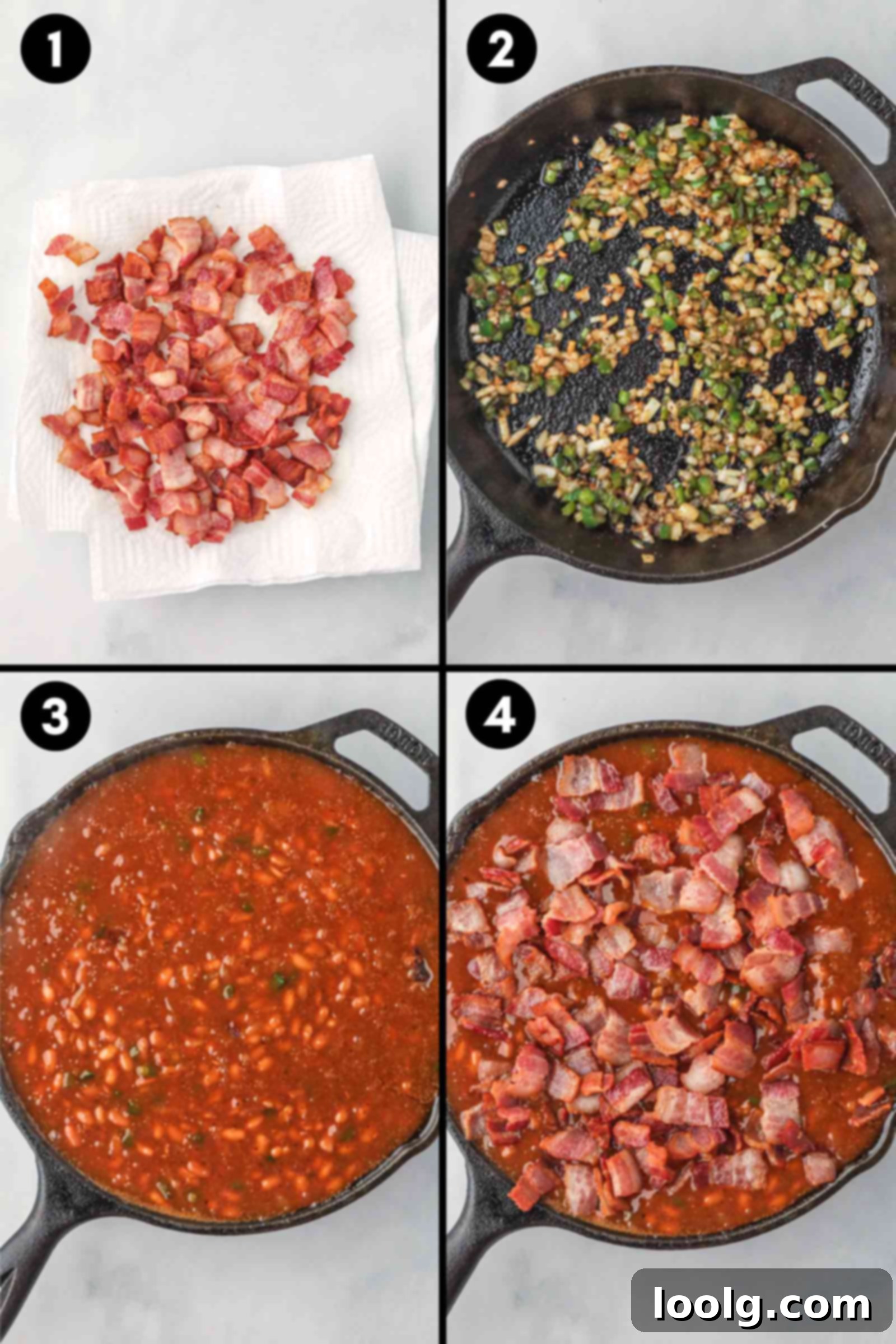
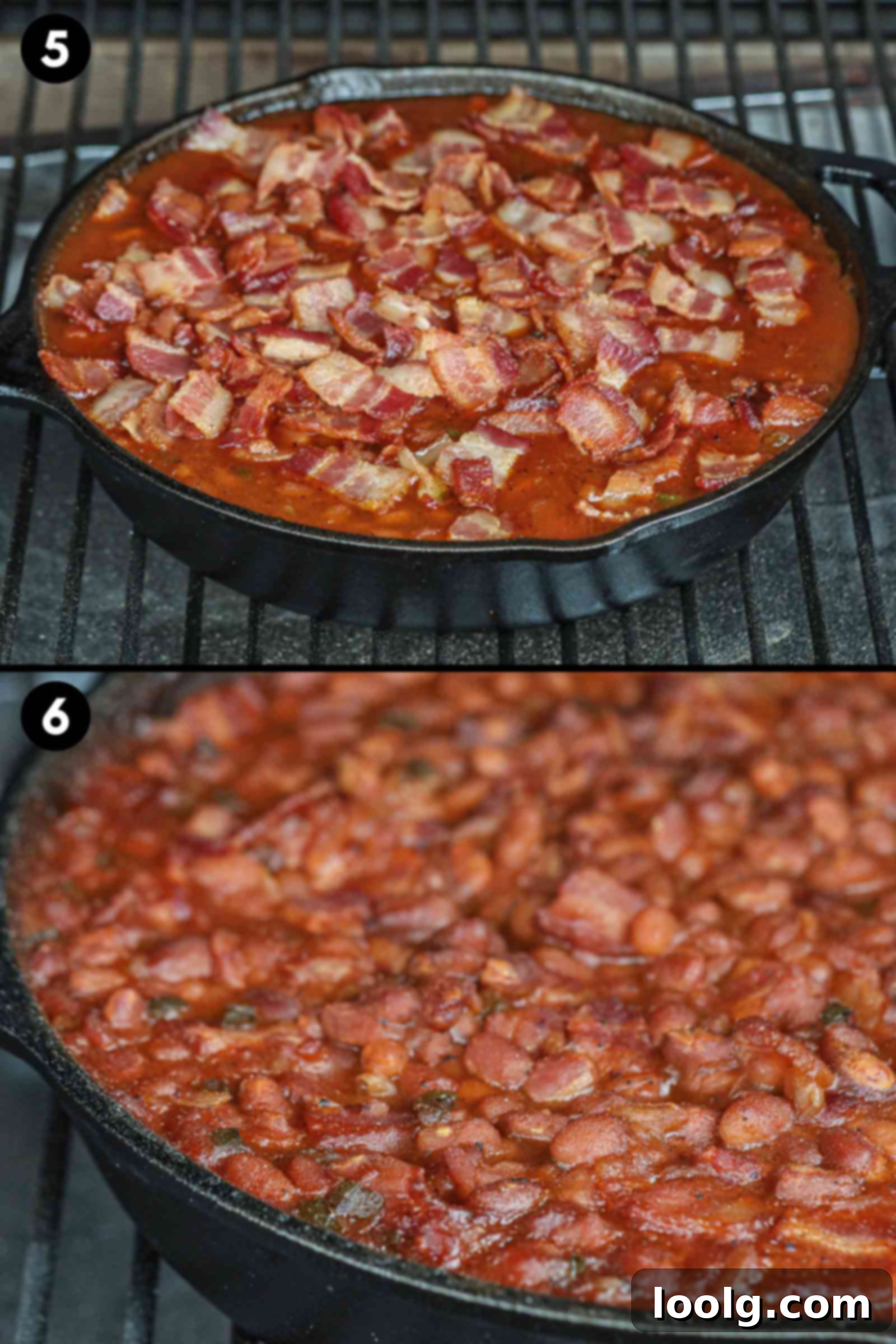
Storage and Make-Ahead Instructions
These smoked baked beans are not only delicious when served fresh but also incredibly flavorful as leftovers, with the tastes often deepening and becoming even more complex overnight. Here’s how to properly store and prepare them in advance:
- **Make Ahead (Refrigeration):** These beans are an ideal make-ahead dish, perfect for preparing a day or two before your event. Once cooked, allow the beans to cool completely to room temperature. Transfer them into an airtight container, cover tightly, and refrigerate for up to 4 days. When you’re ready to serve, gently rewarm them. You can do this on your smoker (if still running) or in a low oven preheated to 300°F (150°C) until they are heated through. If the beans have thickened too much during refrigeration, simply stir in a splash of water, chicken broth, or even a bit of beer to achieve your desired saucy consistency.
- **Freezing:** For longer storage, portion the fully cooled smoked baked beans into freezer-safe containers or heavy-duty freezer bags. Ensure that you remove as much air as possible from the containers to prevent freezer burn and maintain optimal flavor and texture. The beans can be stored in the freezer for up to 3 months. When you plan to enjoy them, remember to thaw them overnight in the refrigerator before reheating on the stovetop or in the oven using the method described above. This makes them a convenient option for quick future meals.
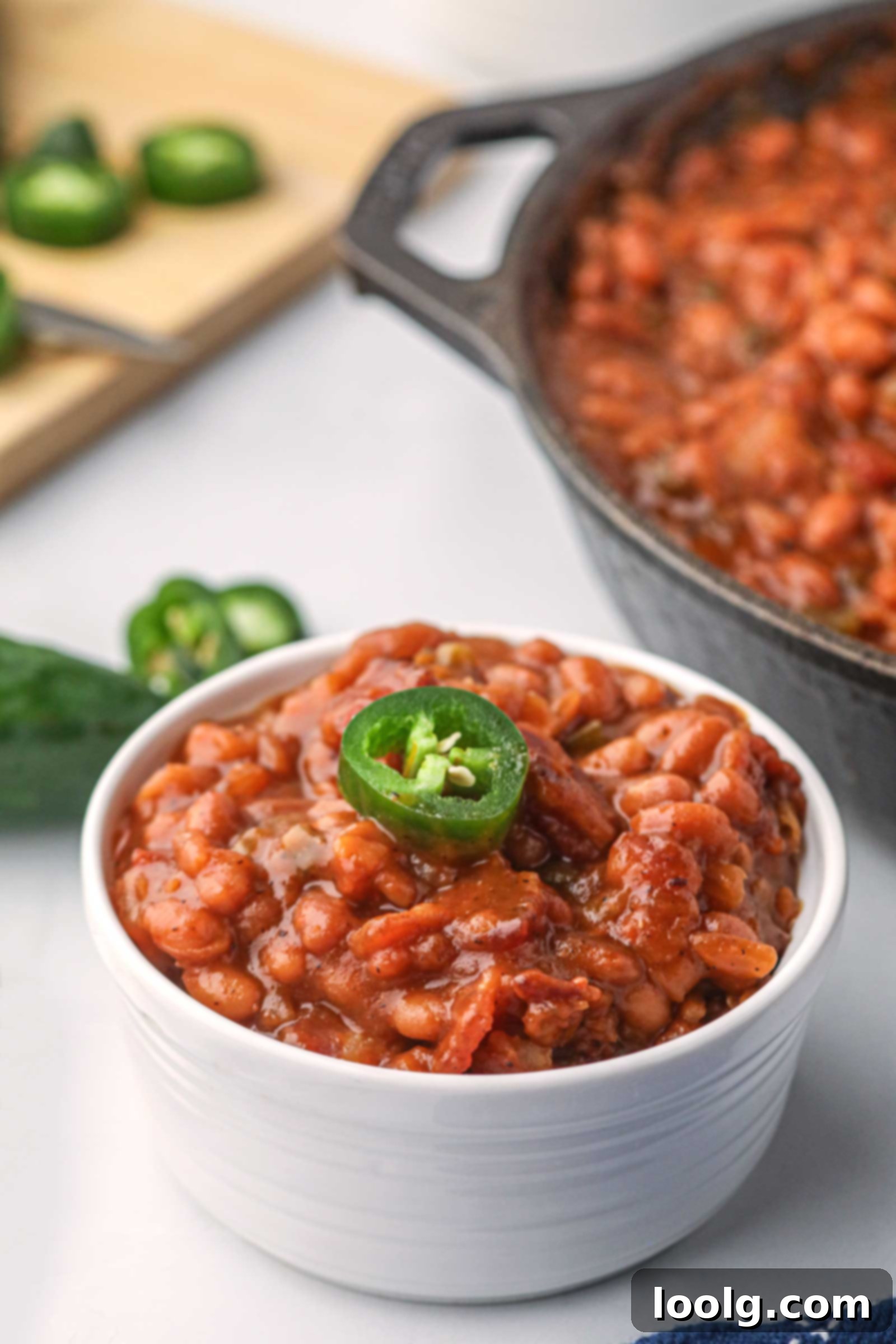
Pro Tips for Smoked Baked Bean Success
- Choose the Right Skillet (Again, It’s Important!): This piece of advice is worth repeating because it’s truly essential for a successful outcome. A standard 12-inch (30 cm) cast iron skillet with sufficient depth is non-negotiable. Using a shallow pan will almost certainly lead to the beans bubbling over in your smoker, creating a significant mess and potentially wasting your delicious efforts. The depth is key for containing the volume and allowing for proper simmering.
- Don’t Skimp on the Rendered Bacon Fat: The flavorful fat left in the skillet after cooking the bacon is culinary gold. Make sure to leave a couple of tablespoons in the pan before you start sautéing the onions and jalapeños. This rich fat adds an incredible depth of flavor and contributes significantly to the smooth, silky texture of the finished sauce. It’s a fundamental step in building the robust flavor base of these beans.
- Control Your Sweetness to Taste: Sweetness is a very personal preference. My recommendation is to start with slightly less brown sugar and molasses than the recipe initially calls for. After the beans have been smoking for a couple of hours, taste them. You can then easily add more brown sugar or molasses, stirring until dissolved, if you prefer a sweeter profile. It’s always simpler to add sweetness than to try and reduce it later.
- Make it a Heartier Meal with Extra Protein: If you want to transform these fantastic baked beans from a side dish into a more substantial meal, consider adding extra protein. Near the end of the smoking process, stir in some pre-cooked ingredients like leftover pulled pork, chopped smoked sausage, or tender brisket. This addition not only makes the dish more filling but also enhances its savory depth, perfect for a casual family supper or a potluck.
- Monitor Your Smoker Temperature Religiously: Consistency is absolutely critical when smoking. Ensure that your smoker maintains a steady temperature of 250°F (120°C) throughout the entire cooking process. Significant temperature fluctuations can lead to uneven cooking, an undesirable texture, or a less optimal smoke flavor. A good quality thermometer is your best friend here.
- Stir Occasionally for Evenness: During the smoking phase, it’s beneficial to gently stir the beans every 30-45 minutes. This simple action helps prevent the bottom layers from scorching, encourages a more even thickening of the sauce, and ensures that the smoky flavor permeates uniformly throughout all the beans, resulting in a perfectly balanced dish.
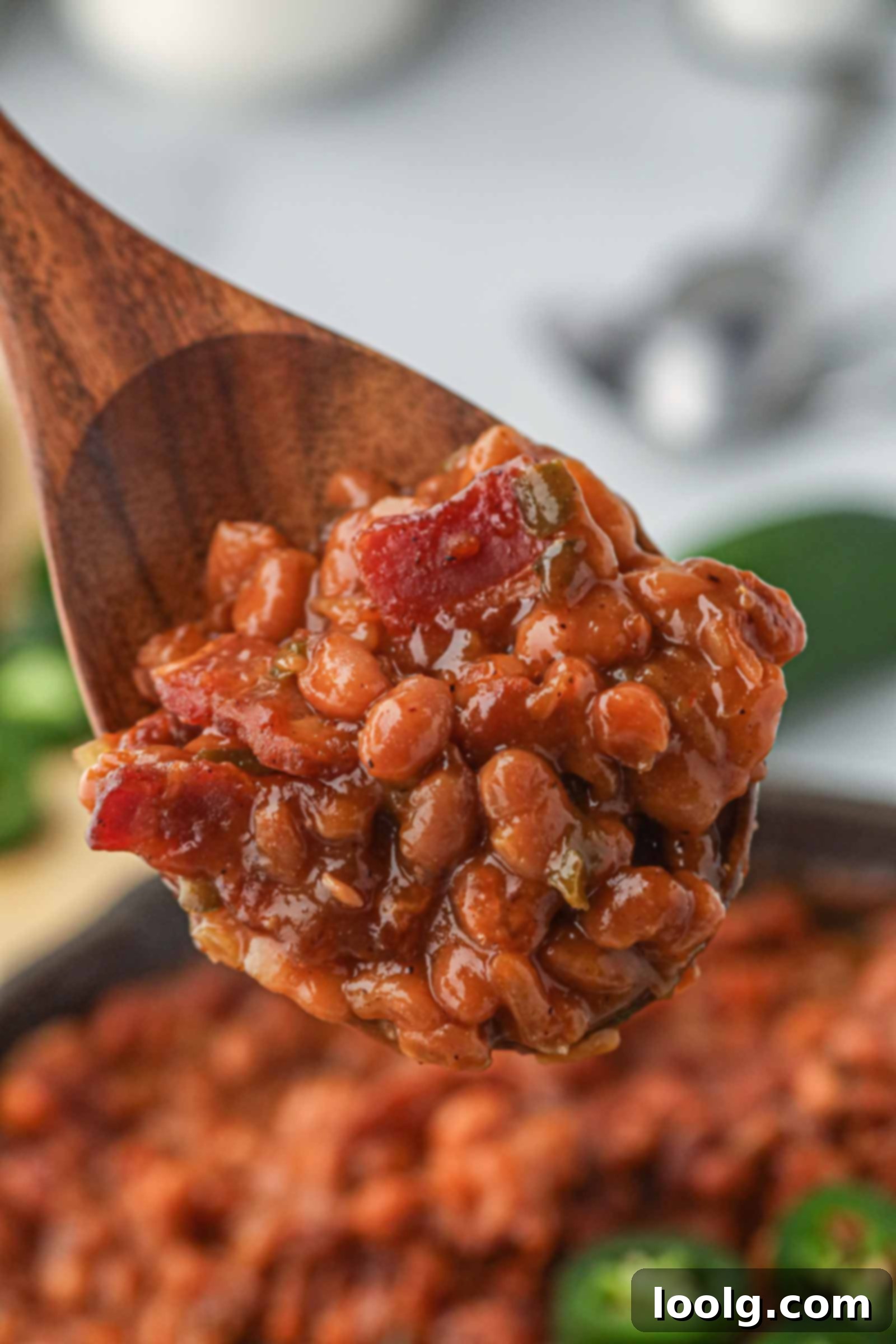
Troubleshooting Common Issues
Even for experienced cooks, a recipe can sometimes throw a curveball. Here’s how to troubleshoot common issues you might encounter while making your smoked baked beans, ensuring a perfect batch every time:
- Too Watery? If your beans are not thickening to your desired rich, saucy consistency, don’t fret. The easiest solution is to simply extend the smoke time, keeping the skillet uncovered. Continue to stir the beans periodically (every 30-45 minutes); this action encourages evaporation and reduction of the sauce. A little extra time, even another hour, can make a significant difference in achieving that perfectly thick and luscious texture.
- Too Thick? Did your beans become a bit too robust and dense? This is an easy fix! To loosen the sauce to your preferred consistency, stir in a splash of liquid. Start with about 1/4 cup of water, chicken broth, or even your favorite beer, adding it gradually and stirring well after each addition until the texture is just right.
- Too Sweet? If you find that the flavor balance has tipped too far towards sweetness, you can easily restore harmony. Add a touch more apple cider vinegar (start with 1 tablespoon) or an extra pinch of dry mustard. Both ingredients are excellent for cutting through excessive sweetness and will help to reinstate a more balanced, tangy-savory profile that is characteristic of great baked beans.
- Not Smoky Enough? The intensity of smoke flavor can vary based on your specific smoker, the type of wood used, and your personal preference. If your beans aren’t as smoky as you had hoped, you have a couple of effective options. For the current batch, you can simply extend the smoke time to allow for more smoke absorption. For future batches, consider using a slightly stronger type of wood (for example, switching from a mild pecan to a more assertive hickory) to impart a more pronounced smoke note.
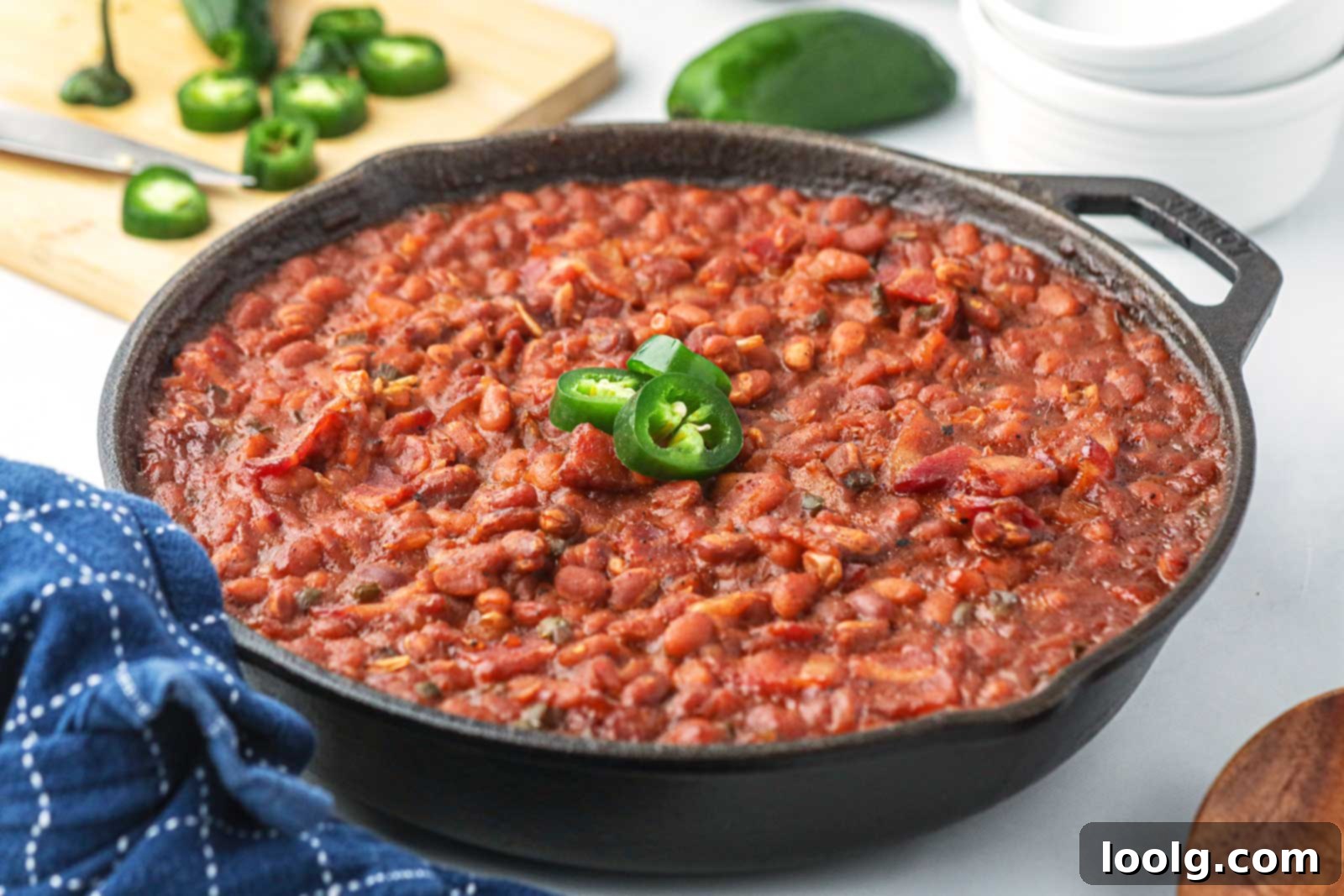
What to Serve with Smoked Baked Beans
These versatile smoked baked beans are the quintessential barbecue side dish, pairing beautifully with a wide array of mains and other classic accompaniments. Their sweet, smoky, and savory profile makes them a welcome addition to almost any comfort food spread. Here are some favorites that truly shine alongside them:
- Smoked Chicken Thighs – The juicy, flavorful smoked chicken is a classic and utterly unbeatable pairing for these rich, saucy beans. The flavors complement each other perfectly.
- Cheesy Mashed Potatoes – The creamy, comforting texture and savory richness of cheesy mashed potatoes provide a delightful contrast to the smoky and tangy beans.
- Venison Burgers – The robust, slightly gamey flavor of venison burgers is wonderfully complemented by the sweet and smoky notes of the baked beans, creating a truly memorable and hearty meal.
- Air Fryer Red Potatoes – Crispy on the outside and fluffy on the inside, these red potatoes are excellent for scooping up every last bit of that delicious, flavorful bean sauce.
- Smoked Ribs or Pulled Pork – For the ultimate, traditional BBQ feast, these beans are an absolute must-have alongside tender, slow-smoked ribs or a pile of juicy, fall-apart pulled pork. They complete the plate.
- Grilled Corn on the Cob – A fresh, naturally sweet contrast to the savory and smoky beans, grilled corn on the cob adds another vibrant layer of classic summer barbecue flavor and texture.
- Fresh Coleslaw – The crisp, refreshing, and tangy qualities of a good coleslaw offer a fantastic counterpoint to the richness and depth of the smoked beans, providing a palate cleanser between bites.
- Cornbread – A warm, fluffy slice of cornbread is absolutely perfect for soaking up the delicious, savory, and slightly sweet sauce of the baked beans, ensuring no flavor goes to waste.
✨🍴 Have you tried these incredible smoked baked beans yet? 🍴✨
Please take a moment to leave a ✍️ review and 🌟 rating – your feedback genuinely helps me and other home cooks discover new favorites! I so appreciate it. 💖
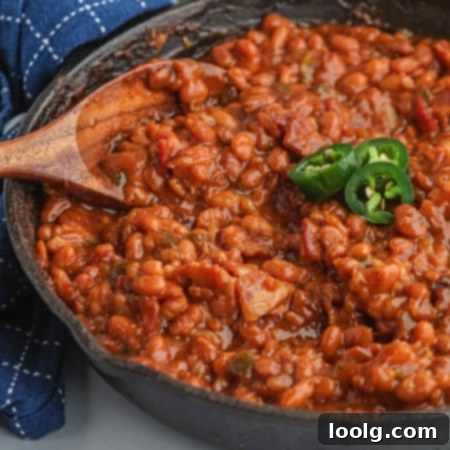
Smoked Baked Beans
Ingredients
- 8 ounces (227 grams) thick-cut bacon
- 1 cup (150 grams) diced yellow onion
- 2 jalapenos finely diced and seeds removed unless you want it spicy (the beans aren’t spicy without the seeds)
- 56 ounces (1587 grams) canned pork and beans
- 1/3 cup (67 grams) light brown sugar
- 1/4 cup (68 grams) ketchup
- 1/4 cup (60 ml) apple cider vinegar
- 2 tablespoons (44 grams) molasses not blackstrap
- 2 teaspoons dry mustard
Instructions
-
Set your smoker to preheat at 250°F (120°C). Use a mild wood like apple, cherry or pecan.
-
In a 12″ (30 cm) cast iron skillet, cook the bacon over medium heat until it’s halfway done on both sides, about 4-7 minutes.
-
Once partially cooked, transfer the bacon to a plate lined with paper towels to drain. Leave about 2 tablespoons of bacon grease in the skillet, and when the bacon has cooled, chop it into bite-sized pieces.
-
In the bacon skillet with the bacon grease, add the diced onion and jalapenos, cooking at medium heat for about 5-7 minutes until they become soft and aromatic.
-
Stir in the pork and beans, brown sugar, ketchup, apple cider vinegar, molasses and mustard. Combine everything thoroughly and let the mixture simmer briefly, about 3 minutes.
-
Spread the cooked bacon pieces evenly on top of the beans.
-
Place the skillet in the smoker and let it cook for 2-3 hours, uncovered, stirring occasionally to ensure even cooking and allow the flavors to meld. The longer you smoke, the thicker the consistency.
-
Once the beans reach your desired consistency, carefully remove the dish from the smoker and let it rest for a few minutes before serving.
-
Store in an airtight container for up to 4 days. Reheat on the stove or in the oven, adding a splash of water if the mixture becomes overly thick.
Notes
- The nutrition information provided is calculated as a courtesy and is only an estimate. I am not a licensed nutritionist or dietitian. For the most accurate nutritional data, consult a professional or use your preferred calculator.
- If you’re gluten-free or dairy-free – pork and beans and ketchup are almost always gluten-free and dairy-free, but it’s always smart to double-check your pork and beans and ketchup labels just to be safe.
